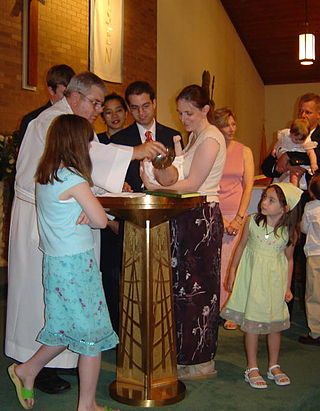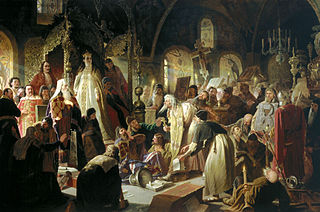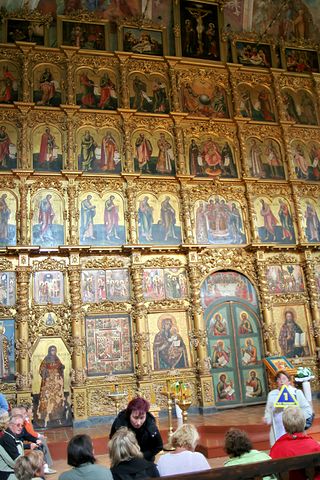
Anointing of the sick, known also by other names such as unction, is a form of religious anointing or "unction" for the benefit of a sick person. It is practiced by many Christian churches and denominations.

Infant baptism is the practice of baptizing infants or young children. Infant baptism is also called christening by some faith traditions.

Avvakum Petrov was a Russian Old Believer and protopope of the Kazan Cathedral on Red Square who led the opposition to Patriarch Nikon's reforms of the Russian Orthodox Church. His autobiography and letters to the tsar and other Old Believers such as Boyarynya Morozova are considered masterpieces of 17th-century Russian literature.

Penance is any act or a set of actions done out of repentance for sins committed, as well as an alternate name for the Catholic, Lutheran, Eastern Orthodox, and Oriental Orthodox sacrament of Reconciliation or Confession. It also plays a part in confession among Anglicans and Methodists, in which it is a rite, as well as among other Protestants.

In Christian denominations that practice infant baptism, confirmation is seen as the sealing of the covenant created in baptism. Those being confirmed are known as confirmands. For adults, it is an affirmation of belief. The ceremony typically involves laying on of hands.

Old Believers or Old Ritualists are Eastern Orthodox Christians who maintain the liturgical and ritual practices of the Russian Orthodox Church as they were before the reforms of Patriarch Nikon of Moscow between 1652 and 1666. Resisting the accommodation of Russian piety to the contemporary forms of Greek Orthodox worship, these Christians were anathematized, together with their ritual, in a Synod of 1666–67, producing a division in Eastern Europe between the Old Believers and those who followed the state church in its condemnation of the Old Rite. Russian speakers refer to the schism itself as raskol (раскол), etymologically indicating a "cleaving-apart".

The Schism of the Russian Church, also known as Raskol, was the splitting of the Russian Orthodox Church into an official church and the Old Believers movement in the mid-17th century. It was triggered by the reforms of Patriarch Nikon in 1653, which aimed to establish uniformity between Greek and Russian church practices.

The Byzantine Rite, also known as the Greek Rite or the Rite of Constantinople, is a liturgical rite that is identified with the wide range of cultural, devotional, and canonical practices that developed in the Eastern Christian church of Constantinople.

Making the sign of the cross, or blessing oneself or crossing oneself, is a ritual blessing made by members of some branches of Christianity. This blessing is made by the tracing of an upright cross or Greek cross across the body with the right hand, often accompanied by spoken or mental recitation of the Trinitarian formula: "In the name of the Father, and of the Son, and of the Holy Spirit. Amen."

Russian Orthodoxy is the body of several churches within the larger communion of Eastern Orthodox Christianity, whose liturgy is or was traditionally conducted in Church Slavonic language. Most Churches of the Russian Orthodox tradition are part of the Eastern Orthodox Church.
The Popovtsy or Popovschina are a Christian group in Russia which originated in the 17th century. They were one of the two main factions of Old Believers, along with the Bezpopovtsy.
Filippians or Philippians was a soglasiye of the Bespopovtsy strain of Old Believers. They detached themselves from Pomortsy under the leadership of a "teacher" Filipp at the beginning of the 18th century. Because of the repressions of the government, they started practicing self-immolation as a means for the "preservation of the faith". In the second half of the 18th century, their fanaticism decreased, and several other confessions were spun off: Aaronovtsy, Shepherd's Confession, and many others.
Spiritual Christianity is the group of belief systems held by so-called folk Protestants, including non-Eastern Orthodox indigenous faith tribes and new religious movements that emerged in the Russian Empire. Their origins are varied: some come from Protestant movements imported from Europe to Russia by missionaries, travelers and workers; others from disgust at the behavior of Orthodox priests, still others from the Bezpopovtsy Raskolniks. Those influences have mixed with folk traditions resulted in communities that are collectively called sektanty (sectarians). Such communities were typically documented by Russian Orthodox clergy with a label that described their heresy such as not fasting, meeting on Saturday (sabbatarians), rejecting the spirit, body mutilation (castigators), self-flagellation, or suicide.

Catechesis is basic Christian religious education of children and adults, often from a catechism book. It started as education of converts to Christianity, but as the religion became institutionalized, catechesis was used for education of members who had been baptized as infants. As defined in the Catechism of the Catholic Church, paragraph 5 :
Catechesis is an education in the faith of children, young people and adults which includes especially the teaching of Christian doctrine imparted, generally speaking, in an organic and systematic way, with a view to initiating the hearers into the fullness of Christian life.
The sacraments are viewed as vital ministries in Community of Christ for both individual and community spiritual development. They are viewed as essential to the mission, identity and message of the denomination, providing a common foundation for religious practice across the world. The sacraments practiced by Community of Christ are baptism, confirmation, the Lord's supper, marriage, administration to the sick, ordination, blessing of children, and evangelist's blessing. These latter two are not widely practiced as sacraments in other Christian denominations. Community of Christ does not observe confession as a sacrament.

Grebenstchikov House of Prayer is an Old Believers place of worship in Riga, the capital of Latvia. It is situated at the address 73 Krasta Street.
The Shtundists are the predecessors of several Evangelical Protestant groups in Ukraine and across the former Soviet Union.

A sacrament is a Christian rite that is recognized as being particularly important and significant. There are various views on the existence, number and meaning of such rites. Many Christians consider the sacraments to be a visible symbol of the reality of God, as well as a channel for God's grace. Many denominations, including the Roman Catholic, Lutheran, Presbyterian, Anglican, Methodist, and Reformed, hold to the definition of sacrament formulated by Augustine of Hippo: an outward sign of an inward grace, that has been instituted by Jesus Christ. Sacraments signify God's grace in a way that is outwardly observable to the participant.
A new and more aggressive phase of anti-religious persecution in the Soviet Union began in the mid-1970s after a more tolerant period following Nikita Khrushchev's downfall in 1964.
The dyrniki, or "hole-worshippers", were a group of Old Believers who emerged in the 18th century as a radical branch of the netovshchina, or self-baptizers. They rejected the church reforms of Patriarch Nikon in the 17th century and considered themselves the only true Orthodox Christians. They had some distinctive beliefs and practices that set them apart from other Old Believers and the official Russian Orthodox Church.

















